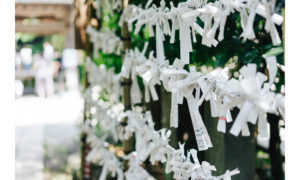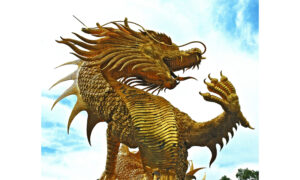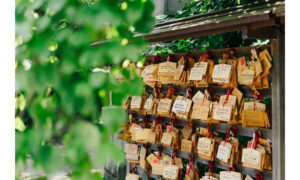
- First Shrine Visit in 2024! Aichi Shrines and Temples Inspired by the Year of the Dragon! – Atsuta Jingu
- “Blessings”
- “Goshuin” (stamp or seal of a shrine or temple indicating that a visit has been made)
- Access
First Shrine Visit in 2024! Aichi Shrines and Temples Inspired by the Year of the Dragon! – Atsuta Jingu

The premier dragon-related shrine in Aichi Prefecture is none other than Atsuta Jingu, located in Atsuta Ward, Nagoya City. Revered as a highly sacred shrine, second only to Ise Jingu, Atsuta Jingu is particularly associated with the Year of the Dragon. The reason? The shrine’s enshrined deity is linked to one of the Three Sacred Treasures of Japan, the Kusanagi-no-Tsurugi (Grass-Cutting Sword).
Historically, swords have been thought of as incarnations of flame dragons. In essence, the shrine’s sacred object itself represents a “dragon”! Notably, the Kusanagi Sword was extracted from the tail of the eight-headed serpent, Yamata-no-Orochi, by the deity Susanoo-no-Mikoto, who then humbly presented it to his sister, the sun goddess Amaterasu.
Atsuta Jingu’s enshrined deity is known as “Atsuta no Okami,” which, in simpler terms, refers to the state of the Kusanagi Sword when the sun goddess Amaterasu descended. Amaterasu, transforming into a sword and a dragon to protect Japan, is present at Atsuta Jingu in the form of the Kusanagi Sword.
Furthermore, Atsuta Jingu has a sub-shrine called “Ryujinsha” or Dragon Deity Shrine. It’s a modest shrine nestled in the quiet woods to the east of the main hall and Kaguraden.
While it might be challenging during the bustling New Year’s visit, consider visiting on another day. Take a stroll through the serene “Kokoro no Komichi” (Path of the Heart) and pay your respects. The shrine honors Kibi Takehiko no Mikoto and Ohotomo Takehiko no Mikoto, who followed Yamato Takeru no Mikoto on his eastern expedition wielding the Kusanagi Sword.
“The dragon is indeed a symbol of martial prowess, swords, and strength.”
“Site Map”
Atsuta Jingu has an area equivalent to about five Tokyo Domes. It takes approximately one hour to walk around the entire precincts.
If it’s crowded during the New Year’s visit, you may not be able to walk at your own pace, so plan for a longer visit.”
“Atsuta Jingu Site Map (Source: Official Website)”
“If you click on the link above, you can download the PDF file.”
“Blessings”
Atsuta Jingu, with its prestigious status second only to Ise Jingu, seems to offer a variety of prayers, and it appears to be an real almighty.
Blessings include:
– Safety of the family
– Prosperity in business
– Fulfillment of various wishes
– Physical health
– Freedom from illness
– Good luck and inviting fortune
– Matchmaking
– Safe childbirth
– Removal of misfortune
– Academic success
– Success in examinations
– Prosperous business
– Safety of the family
For business owners, those in agriculture, industry, and those employed, the “Hatsu Ebisu” on January 5th is very popular. There are also amulets for Ebisu-sama available.”
“Goshuin” (stamp or seal of a shrine or temple indicating that a visit has been made)
At Atsuta Jingu, they call it ‘Goshinin,’ and you can obtain it at the Juyojo (Issuance Office) next to the main shrine.
However, considering that around 2.3 million visitors are expected during the year-end and New Year period, it might be advisable to purchase a Goshinincho (stamp book) that has already been stamped by the shrine.
The Issuance Office is usually open until sunset, but during the year-end and New Year, it stays open later.
You can also purchase ofuda (amulets) and omamori (charms) here.
For inquiries related to the Issuance Office, you can contact the Festival Affairs Department at 052-671-4152.
Access
Atsuta Jingu is located in the central part of Nagoya City.
Atsuta Jingu is conveniently located in Nagoya City, Aichi Prefecture. You can access it easily by various means:
– **Address:** 1-1-1 Jingu, Atsuta Ward, Nagoya, Aichi 456-8585, Japan
Public Transportation
Subway Meijo Line – Daimoncho Station
15 minutes on foot from Exit 1
Subway Meijo Line – Atsuta Jingu Nishi Station
15 minutes on foot from Exit 2″
“From the night of December 31st to the early morning of New Year’s Day, the Meijo Subway Line will operate on a special schedule with trains running every 30 minutes.
From Meitetsu Jingu-mae Station to Atsuta Jingu Nishi Gate, it’s a 15-minute walk. From the East Gate, it’s a 10-minute walk. *Currently, the route from the East Gate may not be available on Google Maps, but it should be accessible during the New Year’s visit.
For city buses, please use the ‘Meitetsu Jingu-mae Bus Stop’ on the ‘Meitetsu Jingu 11’ and ‘Meitetsu Meieki 18’ routes. The buses operate on a Sunday and holiday schedule.
Parking
Atsuta Jingu has a free parking lot with a capacity of approximately 400 cars, but to avoid congestion, it cannot be used from December 31st to January 5th.
We recommend using public transportation to visit. If you must come by car, please consider checking the paid parking lot at ‘Kojima x Bic Camera Atsuta Store’.
2-4-22 Daibao, Atsuta-ku, Nagoya, Aichi 456-0062
Phone: 052-684-1421
Business Hours: 10:00 AM – 8:00 PM
It appears to be open year-round, but we recommend making a prior inquiry by phone.
It takes about 20 minutes on foot from where you park to Atsuta Jingu. Approaching closer may lead to traffic congestion, and it seems there is no available parking space nearby.
“New Year’s Visit 2024! Aichi Shrines and Temples Associated with the Year of the Dragon – Yaotomi Shrine”

The charming Yaotomi Shrine is located on the picturesque island of Takeshima in Mikawa Bay.
Accessible by bridge from the opposite shore, similar to Enoshima and its shrine, as well as Chikubu Island in Lake Biwa and Itsukushima Shrine in Hiroshima, it is dedicated to Benzaiten-sama!”
Benzaiten-sama’s deep connection with the Dragon God can be briefly explained. Originally, Benzaiten was Saraswati, a river goddess in Hinduism. She was considered both a water deity and a serpent deity.
Similarly, the Dragon God governs the sea, rain, and water, with its body symbolizing the turbulent rivers that cause massive floods. In a way, they are kindred spirits.
In Enoshima, there is a dragon called ‘Gozuryu’ who fell in love with Benzaiten, and he is enshrined as a Dragon God at the Ryukohmyojin Shrine on the opposite side of Enoshima.
Similarly, here on Takeshima, there is a dedicated shrine named ‘Hachidai Ryu Shrine’ within the island, venerating the sea deity Toyotama-hiko-no-mikoto. Benzaiten-sama, also known as ‘Ichikishima-hime-no-mikoto’ in the Kojiki and Nihon Shoki, is the goddess of the sea called ‘Munakata Sanjojin.’
When these two deities are together, their divine influence is profound, bringing blessings for rain, maritime safety, and various miracles.”
“Blessings”
“Benzaiten-sama, often depicted with a biwa, a traditional Japanese instrument, is believed to assist in artistic pursuits. Additionally, she is known for enhancing financial fortune and business success.
Moreover, Yaotomi shrine meaning the Eight Hundred Fortune Shrine was founded by Fujiwara Toshinari, a poetic genius who compiled the ‘Senzaiwakashu’ (Collection of thousand waka poems), a poetic anthology commissioned by the emperor. He is also the father of Fujiwara Teika.
Within the shrine precincts, there is also the ‘Senzai Shrine’ dedicated to him, making it conducive to academic achievements.
The shrine is sought for blessings related to matchmaking, successful relationships, improvement in various arts, realization of heartfelt wishes, academic success, exam success, safe childbirth, overall well-being, recovery from illness, and more.”
“Goshuin”
You can obtain the stamps from both Yaotomi Shrine and Hachidai Ryu Shrine. Please inquire at the shrine office.
The reception hours are from 9:00 AM to 4:30 PM, and the last collection is at 5:00 PM. Feel free to purchase charms, amulets, and other items during this time.
Access
- Address: 3-15 Takeshima-cho, Gamagori City, Aichi 443-0031
- Phone: 0533-68-3700
Public Transportation
15 minutes on foot from JR Tokaido Main Line Gamagori Station.
Meitetsu Bus: Take the Meitetsu bus “Toho Mikawa Otsuka Station” from Gamagori Station for 5 minutes, get off at Takeshima Amusement Park Bus Stop, and walk for 3 minutes.
(As the number of buses is limited, please check the schedule on the Meitetsu Bus website in advance.)
Parking
Please use the Takeshima Park Municipal Parking Lot.
Weekends and holidays: 300 yen/day (free on weekdays), capacity of approximately 200 cars.
In case of full occupancy, please use the Takeshima Aquarium Front Parking Lot, which can accommodate approximately 40 cars.
For the New Year’s holiday business hours, please check in advance on the official website or other sources.
New Year’s Visit 2024! Aichi Shrines and Temples Associated with the Year of the Dragon –Takamu shrine

*The image is for reference only.
Takamu Shrine, also known as “Furui no Hachiman-sama,” is famed for its ancient wellspring, renowned as one of Japan’s selected “Hundred Famous Waters.” The crystal-clear water from this old well is protected by the Dragon God, majestically presiding over the hand-washing pavilion.
Nestled deeper within the shrine grounds stands the sacred hall of “Takamu Ryujin Shrine.” This area is dedicated to the Dragon God, symbolizing the purity and vitality of the water. This shrine serves not only as a spiritual haven but also as a testament to Japan’s rich natural heritage and reverence for water deities.
Visitors to Takamu Shrine can experience the tranquility and spiritual ambiance of this site, where the ancient water source and its divine guardian offer a unique blend of natural beauty and spiritual significance.
This water, not only bestowed for longevity, has also gained fame as “Koi (love) Water” from the ancient well. Alongside Jozan Hachiman-gu with its “Renri no Ki” (conjoined trees) and Yamada Tenmangu with its “Yorisoi Ishi” (snuggling stone), Takamu Shrine is celebrated as one of Nagoya’s three major shrines for romantic fulfillment, attracting a continuous stream of female visitors.
The deities enshrined here are Takamimusubi-no-Kami, Kamimusubi-no-Kami, and Emperor Ojin (known as Homudawake-no-Mikoto). These three deities comprise a pair of life-giving gods responsible for the birth and nurturing of all living beings, and a deity revered throughout Japan for excellence in both scholarly and martial pursuits, commonly worshipped as Hachiman.
At the entrance, on the left, stands a “Nade-ushi” (stroking cow) statue. This feature is common in Tenmangu shrines across the country, perhaps due to the presence of a branch shrine of Kitano Tenmangu here.
Touching the statue of the cow is believed to transfer one’s physical ailments to the cow, which graciously takes on those burdens.
Blessings
As the “God of Bonds” nurturing life and with the aspect of “Travel Safety” befitting Emperor Ojin, this shrine encompasses various blessings:
– Matchmaking
– Fertility
– Fulfillment of heartfelt wishes
– Household safety
– Warding off misfortune
– Traffic safety
– Safe travels
– Success in exams
– Recovery from illness
– Safety in construction work
– Prosperity in business
Goshuin
At the shrine office to the left of the main hall, you can receive it for a “hatsuho-ryo” (first-fruit offering) , 300 yen.
Reception hours: 9:00 AM to 4:00 PM. They seem to write the Goshuin in front of you with Sumi-ink, but keep in mind that it might be crowded during the New Year’s visit.
Access
Takamu Shrine is located very close, just beyond Imaike and Sakae, passing through Chikusa.
- Address: 1-4-18 Imaike, Chikusa-ku, Nagoya, 464-0850
- Phone: 052-731-2900
Public Transportation
From Chikusa Station on the Subway Higashiyama Line or JR Chuo Main Line:
Take the Chikusa Station East Exit and walk for 4 minutes.
From Imaike Station on the Subway Higashiyama Line or Sakuradori Line:
Take Exit 9 and walk for 7 minutes.
Parking
The shrine does not have a parking lot. We recommend using public transportation.
There is a parking lot with a capacity of 60 cars at the “Chikusa Terminal Building” in front of Chikusa Station. Since there are no reviews, please call in advance to confirm.
Address: 3-25-6 Uchiyama, Chikusa-ku, Nagoya, 464-0075
Business Hours: 7:30 – 23:00
Maximum Fee: ¥800 from 7:30 to 23:00
New Year’s Visit to Shrines and Temples in 2024! Aichi’s Shrines and Temples Associated with the Year of the Dragon”ーHakuryu Shrine

This shrine prominently features the word Ryu ‘龍’ (dragon) in its name. Despite being within walking distance from Nagoya Station, it remains relatively unknown and carries an air of mystery.
This is because the shrine has been cherished by those who revere ‘白龍さん’ (Hakuryu-san), and it has not been heavily commercialized as a tourist destination. Photography and video recording for public sharing are discouraged, and if necessary, permission must be sought before uploading any content of the shrine on the internet. Please be mindful of these guidelines.
Visiting the shrine reminds us that it is a religious facility, supported by its devoted followers. The deities enshrined here are collectively referred to as ‘Hakuryu Daishin,’ comprising Takaokami no Kami and Susanoo no Mikoto. ‘Okami’ in Takaokami no Kami is an ancient word for dragon.”
Takaokami no Kami is a dragon deity, known for residing atop mountains, creating thunder and bringing rain. Susanoo no Mikoto, often perceived as boisterous, is also theorized to symbolize storms and tempests. This deity is known for promoting afforestation and flood control, highlighting a deep connection with water.
Blessings
The divine power of purifying and cleansing with water seems to be strong.
Blessings for household safety, recovery from illness, prosperity in business, warding off misfortune, purification for opening a new business, and purification for moving into a new residence.
Goshuin
The issuance of the Goshuin stamp here involves receiving a pre-stamped paper. You can either affix it to your Goshuin-cho (booklet for collecting Goshuin stamps) yourself or file it separately.
Operating hours: Every day from 10:00 to 16:00.
Please refrain from calling to check the availability of prepared Goshuin stamps. Especially during festivals or the year-end and New Year period, phone inquiries may not be accommodated.
It’s important to prioritize the act of worship, and collecting Goshuin stamps should not overshadow the main purpose. Please be mindful of this.
Access
In the past, the shrine was located near the Yanagibashi Bridge, which spanned over the Egawa (now a road and underground waterway). The sacred Yanagi (willow) tree associated with the shrine also used to grow along the Egawa.
For directions, aim for the Egawa Line Yanagibashi Intersection.
- Address: 1-8-14 Meieki Minami, Nakamura-ku, Nagoya, 450-0003
- Phone: 052-571-5859 (9:00 AM to 5:00 PM)
Please refrain from calling on event days and the first three days of the New Year.
Public Transportation
– Meitetsu/Kintetsu: Get off at Nagoya Station, 15 minutes on foot.
– Subway (Higashiyama Line): Get off at Nagoya Station, 15 minutes on foot.
– Subway (Higashiyama Line/Tsurumai Line): Get off at Fushimi Station, 12 minutes on foot.
– Subway (Sakura-dori Line): Get off at Kokusai Center Station, 10 minutes on foot.
– City Bus: Get off at “Yanagibashi” bus stop, 3 minutes on foot.
Parking
The shrine does not have a parking lot. Please use public transportation if possible. Coin parking or the underground parking at Nagoya Station can be utilized, but we cannot predict the congestion during the New Year.
New Year’s Visit to Shrines and Temples in 2024! Aichi’s Shrines and Temples Associated with the Year of the Dragon

How about that?
We introduced shrines deeply connected to Aichi in the “2024, Year of the Dragon” that you might want to visit for the New Year!
Atsuta Jingu
Yaotomi Shrine
Takamu Shrine
Hakuryu Shrine
All of them are related to the Dragon God and the life-source water!
Whether you were born in the Year of the Dragon or not, let’s wash away the impurities of the past and soar into a prosperous and leaping 2024, like a dragon in the sky.
Let’s make the first shrine visit, shall we?



コメント